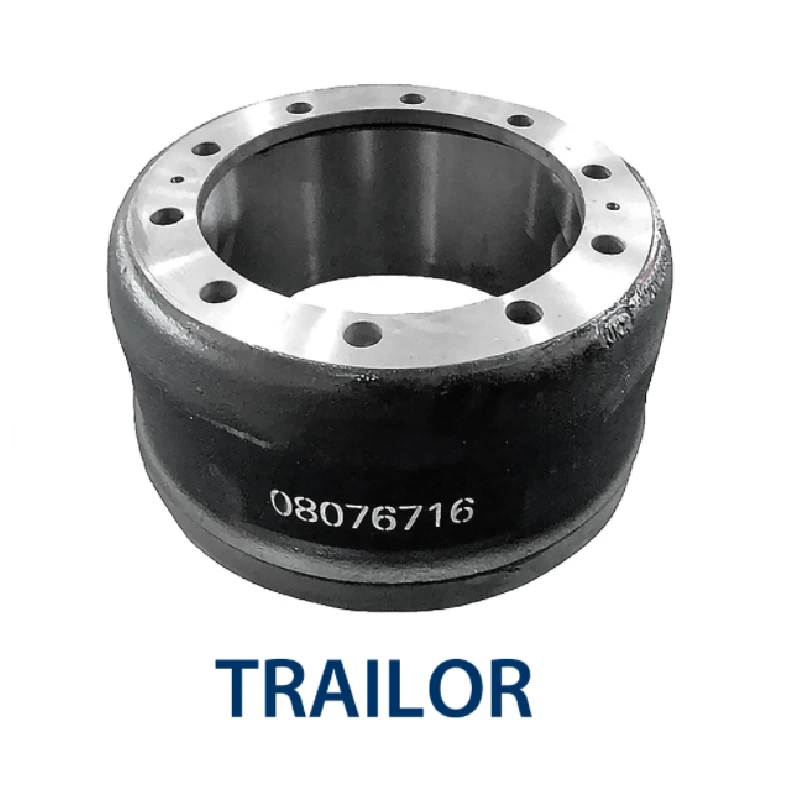Dec . 07, 2024 03:22 Back to list
cast iron brake drum
The Significance and Advantages of Cast Iron Brake Drums
The automotive industry has continuously evolved, introducing advanced technologies and materials to enhance vehicle safety and performance. One fundamental component that plays a crucial role in vehicle braking systems is the brake drum. Among various materials used for brake drums, cast iron stands out due to its exceptional properties and benefits. This article delves into the advantages of cast iron brake drums, their applications, and the considerations for their use.
Understanding Cast Iron
Cast iron is an alloy of iron, carbon, and silicon, known for its high durability and excellent machinability. The material is produced by melting iron and adding carbon before casting it into a mold to create a solid form. Cast iron's structural integrity and resistance to wear have made it a favorite choice in many industrial applications, particularly in automotive components.
Advantages of Cast Iron Brake Drums
1. Superior Heat Dissipation One of the primary advantages of cast iron brake drums is their ability to dissipate heat effectively. During braking, friction generates significant heat, which can lead to brake fade if not managed properly. The dense structure of cast iron allows it to absorb and disperse this heat, maintaining consistent braking performance even under heavy loads or prolonged use.
2. Durability and Longevity Cast iron is inherently tough and resistant to abrasion, making it an excellent material for brake drums that endure constant wear and tear. Compared to other materials, cast iron brake drums typically have a longer lifespan, reducing the frequency and cost of replacements.
3. Performance in Wet Conditions Cast iron brake drums perform favorably in wet conditions. The material's properties allow for effective braking performance even when exposed to moisture, making vehicles equipped with cast iron drums safer in adverse weather.
4. Cost-Effectiveness Although the initial cost of cast iron brake drums may be higher compared to some alternatives, their durability and longevity translate to cost savings over time. Lower maintenance and replacement frequency reduce overall ownership costs for vehicle operators.
cast iron brake drum

5. Compatibility with Various Applications Cast iron brake drums can be used in a vast range of vehicles, from passenger cars to heavy-duty trucks and buses. Their versatility makes them suitable for different driving conditions and requirements, ensuring performance across various applications.
Applications of Cast Iron Brake Drums
Cast iron brake drums are primarily found in conventional braking systems of many vehicle types. They are commonly used in light to heavy commercial vehicles, including trucks, buses, and trailers, where robust braking capabilities are essential for safety. Additionally, many classic cars and vintage models also utilize cast iron brake drums, preserving the authenticity and performance of these vehicles.
In racing and performance vehicles, cast iron brake drums may be employed in specific circumstances. Although most high-performance vehicles have transitioned to disc brakes for optimal performance, cast iron still holds a place due to its ability to withstand significant thermal stress.
Considerations for Use
While cast iron brake drums offer substantial advantages, there are also considerations to keep in mind. The weight of cast iron can impact the overall vehicle weight, potentially affecting fuel efficiency. Vehicle manufacturers must balance performance, safety, and weight when designing braking systems.
Furthermore, proper maintenance is essential. Regular inspections can prevent issues such as warping or cracking, which can occur if the drums are exposed to surface imperfections or extreme heat cycling. Ensuring that the brake drum's surface is smooth and free from debris is critical to maintaining optimal braking performance.
Conclusion
Cast iron brake drums remain a staple in automotive braking systems, owing to their resilience, heat dissipation properties, and suitability for various applications. Despite the competition from newer materials and technologies, cast iron’s unique benefits ensure its continued relevance in the industry. As vehicles evolve, the integration of advanced materials alongside traditional components like cast iron brake drums illustrates the dynamic nature of automotive design, continually striving for enhanced performance and safety.
-
Scania Brake Drums: OEM Quality for Optimal Safety & Durability
NewsAug.16,2025
-
R.V.I: Advanced Remote Visual Inspection for Precision
NewsAug.15,2025
-
Discover HYUNDA: Innovative Vehicles, Equipment & Solutions
NewsAug.14,2025
-
R.V.I: Unlock Advanced Insights & Real-time Performance
NewsAug.13,2025
-
Kamaz Brake Drum: Durable & Reliable for Heavy Duty Trucks
NewsAug.12,2025
-
Heavy Duty Iveco Brake Drum - Premium Quality & Safety
NewsAug.11,2025
